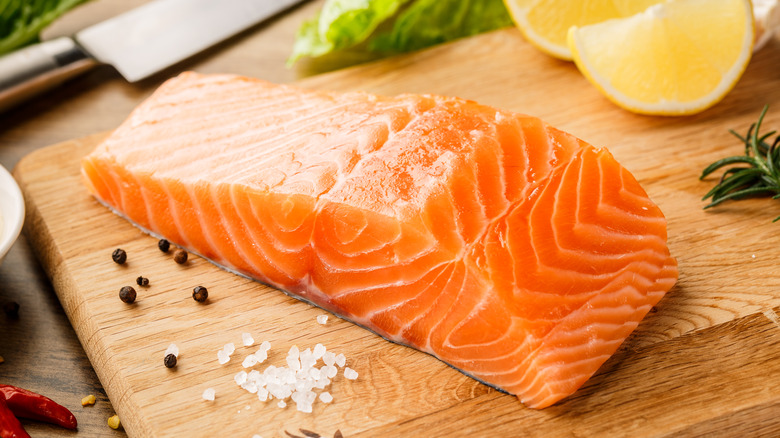Curing Store-Bought Salmon Is The Safest Bet For Raw Preparations
Salmon in all forms is delicious; whether grilled, roasted, or air-fried, we can't get enough of it. Yet, there's something especially delectable about salmon in its natural state. It tastes deliciously fresh when it's raw, rolled up in seaweed and rice, and dipped into soy sauce. While you may want to recreate the same raw salmon dishes at home, it's best to cure the salmon beforehand.
It's one thing to consume raw salmon in a restaurant, but quite different to bring home a salmon filet from the grocery store and slap it right onto a sandwich. It isn't always safe to eat raw salmon – and before you call up the sushi restaurant and claim that they tried to harm you, know that the fish most likely underwent a specific flash-freezing process to limit the risk of foodborne illnesses. While you may not have access to that same fish, curing it is the next best method.
The process is straightforward, but it makes a huge difference between you getting salmonella and eating an incredible piece of salmon. While recipe developer Christina Musgraves uses sashimi-grade salmon to make her homemade cured salmon recipe, you can opt for the regular wild salmon at the grocery store. Curing salmon — which involves rubbing it down in a generous mixture of salt, sugar, and black pepper — helps to kill off any harmful bacteria or parasites within the fish. After salting it, the fish goes through a lengthy refrigeration process, making it ready to eat once removed.
How is cured salmon different from sushi-grade salmon?
Although you can get away with using home-cured salmon in your homemade salmon sushi rolls, the ones at a restaurant may not be the same thing. It's most likely sushi-grade salmon; however, that label doesn't mean much. The only regulation enforced on fish labeled as sushi-grade is that the fishmonger should be the one to determine whether or not it's sushi-grade. No governing body sets the standard.
What hopefully happened before the sushi-grade salmon arrived on your plate starts before the fish even makes its way to the restaurant or fish market. For salmon to be safe when eaten raw, outside of curing it, the fish should have been cut and drained of blood as soon as it was caught. Afterwards, the salmon is gutted, placed on ice, and fast-frozen to kill off any parasites.
While a stellar sushi restaurant may use fish of that grade, the fish you buy from the grocery store may not live up to that standard. Rather than trusting their word, you can cure your salmon to make your own sushi, salmon tartare, and more. The taste will be a little saltier than typical sushi, but they're still quite similar. The longer you cure the salmon, the longer it'll last. While a medium cure of 36 hours can stay in the fridge for two days, hard-curing salmon for three days can make it last for up to five days in the fridge.

